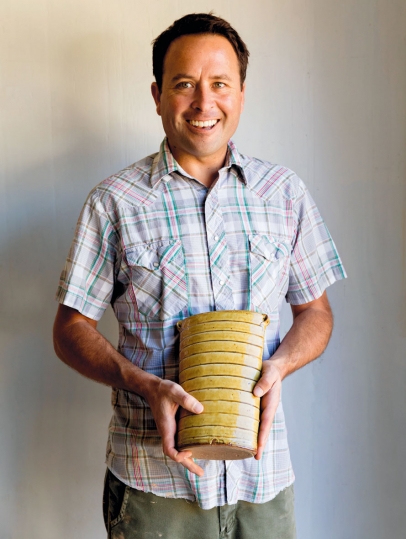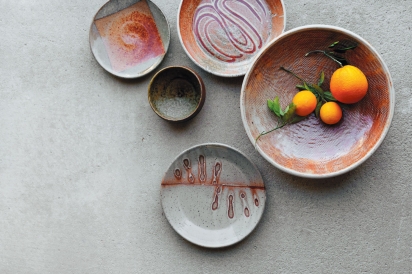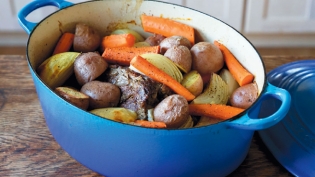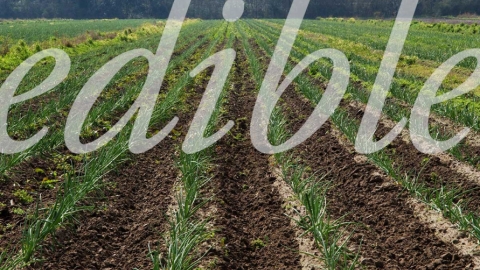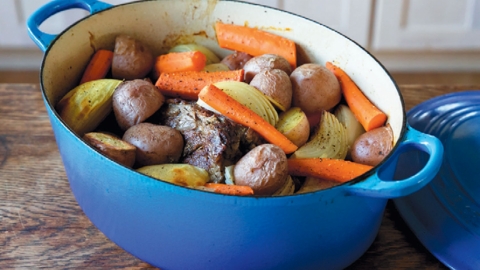Nate Pidduck: Art of the Plate
Food brings potter Nate Pidduck’s creations to life
Heading north out of Santa Paula on Highway 150, the hills to the west have a patchwork of ash like fuzzy mold on an old block of cheese. Turning east, I cross the clacking wood planks of a historic truss bridge painted mint green. Below is Santa Paula Creek, a narrow ribbon of water surrounded by rocks and scrub, while ahead a small wooden sign at the base of a still-lush lemon grove points me to Nate Pidduck’s pottery studio.
At the studio located on Santa Paula Creek Ranch—where he grew up and, in 2012, returned to live after a stint in Chicago—Pidduck, 40, takes me around back to where the Thomas Fire burned within several feet of where both he and his mother, painter Gail Pidduck, make their art. The underbelly of a nearby grapefruit tree is a mass of brown leaves with as much fruit on the ground as on the tree. Miraculously, the fire stopped there, just short of the propane tank Pidduck uses to power his main kiln.
Unless you’re also a potter, Pidduck, has probably spent more time thinking about mugs—along with pots, plates, bowls and vases—than you have. His interest in pottery was sparked by a mug, a wheel-thrown piece he picked up at an art gallery on a post-college road trip around the Southwest.
“I used this mug a lot. I thought about it a lot. I then started wondering how it was made,” he says, explaining what led him to enroll in a ceramics class at Ventura College.
After exhausting the pottery curriculum at the college, Pidduck set up his first studio at a rented home in O’Hara Canyon near Santa Paula. Here he taught himself how to fire with gas by hacking together an electric kiln he had found for free in the classifieds with some gas burners. (Gas firing is less precise than electric but allows the potter to experiment with the atmosphere inside the kiln.) He also experimented with a wood-fired kiln some classmates had set up in Wheeler Canyon. He subsequently moved to Chicago and worked at Lillstreet Art Center before returning to Santa Paula and making his first commercial pieces.
One manifestation of Pidduck’s ongoing attention to his chosen craft is that he still hand-pulls each mug handle, even though it takes longer than throwing the mug itself. It’s a technique that produces a more organic and fluid look while strengthening the clay.
He hopes to bring beauty, pleasure and connection, qualities that, in addition to functionality, Pidduck believes we don’t consider enough in objects made for everyday use. And his pots are for everyday use, fired to vitrification so they don’t absorb water and are therefore safe to use in the microwave, conventional oven and dishwasher.
Despite his ideals, Pidduck is anything but precious about his work. He makes his living as a potter—both from his studio work and as the ceramics lab technician at Ventura College—and relates to pottery both as a vocation and a job. “I like to think I’m adding beauty to daily activities, daily rituals of eating and drinking, but [each creation is] just a pot … It’s not a ‘piece,’ it’s just a pot,” he says with a chuckle.
With that, Pidduck walks me through the creative process, during which it becomes clear that making pottery requires the artisan to be multi-talented. The job is part chemistry, part art and part sheer manual labor. He clearly relishes the end-to-end process, pointing out that the romantic vision of making pottery—time at the wheel—is just one tiny part.
“All of the steps are valuable and worthy, no matter how mundane or simple. They all add up to making that finished pot … and you can express yourself through each of them.”
Our conversation gets so wrapped up in process that Pidduck almost forgets to show me any of his finished work. Displayed toward the front of the studio is a small selection of elegant pots in a palette of earthy reds, buttery yellows and celadon greens, colors he achieves by changing iron oxides.
He lifts a bowl and traces a pattern of ash sprinkled straight from the wood-burning stove onto the dipped glaze. As his finger moves from the foot of the bowl diagonally to the lip, he cites the influence of being around artists, like his mother, who taught him how a good composition leads the viewer’s eye.
There is a noticeable shift in how Pidduck talks about his finished pots versus the process of creating them. “These pots sitting here, I don’t like this. It’s great to hear when someone takes one and then calls me and says, ‘I just had the best meal, I made something in your pot.’ That’s when that pot lives: when it’s being used.”
Spending an afternoon in Pidduck’s company is a convincing argument that what we use to cook and serve food and drink deserves the same level of thoughtfulness as the fare it will contain. “Why not think about that plate or that bowl or that cup? Why not let that be beautiful? Why does it need to disappear so that you don’t even notice it?” It’s enough to make me wince thinking about my own cupboard full of plain white plates.
When he’s not making pottery, Pidduck loves to cook. In fact, he makes his pots with food in mind. A simple pot roast recipe handed down from his grandparents is a favorite. (See the recipe on page 24.)
But what I really want to know is what dishes he uses at home.
He responds with a quote from potter Warren MacKenzie: “Using your own pots is like talking to yourself.” And while he has a single stack of his own dinner plates, he finds that meals taste better when served on something from his collection of work by functional studio potters from around the country. He knows better than anyone that using these pots is what brings them to life.
Pidduck’s pottery is available at Spice-Topia and Paradise Pantry in Ventura, as well as his Santa Paula studio and the Santa Paula Art Museum. For more info, visit NatePidduck.com and Instagram @natepidduckpottery.


